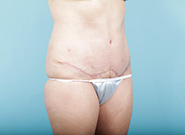Tummy tuck hernia recovery photos Tissue protrudes from the belly button due to a weakening in the abdominal wall, and this condition is known as a hernia. Commonly, it results from a minor weakening in the abdominal wall and is easily corrected through surgery. Any time the abdominal wall is stretched or strained, such during pregnancy, childbirth, or other physical labor, the risk of a hernia increases.
Due to the relaxation of the abdominal muscles during pregnancy, many women experience hernias after giving birth. Also, straining your abdominal muscles through activities like heavy lifting and repeated crunches can cause a hernia. A hernia may be detected by palpating a lump or protrusion just below the skin at the navel (umbilicus). When you have a hernia, your intestines may press outward against the weakening portion of your abdominal wall, causing you to have difficulty passing gas or stool.
You may find it hard to access the right information on the internet, so we are here to help you in the following article, providing the best and updated information on Hernia after tummy tuck pictures, henna tattoo before and after and Can You Tattoo Over A Tummy Tuck Scar

Hernia After Tummy Tuck Pictures
This is a 43 year old female who earlier undergone a life saving abdominal operation that left her with a big hernia. The hernia required repair and she wanted to not only improve her abdomen by correcting the hernia but she wanted to be as flat as possible as well. Pregnancy had also strained the muscles in her abdominal wall and this in conjunction with the hernia gave her abdomen a shape which she wanted to rectify.
BEFOREAFTER


Abdominoplasty
Hernia After Tummy Tuck Pictures
Hernia after tummy tuck is a very common complication that can occur in up to 7% of patients. This complication occurs due to the weakening of the abdominal wall muscles that are pulled apart during surgery, and the resulting weakness of the abdominal wall will allow it to stretch and give way to a hernia. Hernias can happen at any time during your recovery and they vary in size, shape and location.
The types of hernias that may occur after a tummy tuck include:
Anterior Hernias: These occur when a portion of the abdominal muscles are weakened. The hernia will begin as an enlarged belly button or umbilicus area on one side of your abdomen, and it will expand over time into your groin area where you may have pain from straining with bowel movement or heavy lifting activities. It usually occurs between 2-3 weeks post-surgery.
Inguinal Hernias: These occur when a portion of your sigmoid colon has been pulled through an incision made during surgery. These hernias usually don’t require surgery, but if they get




After a lengthy meeting with the patient and her husband as well as a discussion with the general surgeon who would repair the hernia, it was concluded that a tummy tuck (at the same time as the hernia repair) would provide her with the flatest abdomen feasible.
She underwent both treatments without issues and was back to her usual activities within 2 weeks. Her wounds healed beautifully and she enjoys the fact that not only was the hernia corrected, but the excess skin was removed and the abdominal muscles were tightened….all at the same time.
She is shown in these post surgery images around two months following the procedure. Her contour and scars will continue to improve as the scars mature. She is thrilled with her outcomes!
Hernia After Tummy Tuck Pictures
Hernias are a common complication of abdominal surgery. When the stomach is stretched or pulled out of place, it can lead to the development of an internal hernia. Hernias can affect anyone who has had abdominal surgery, even those who have never undergone a procedure.
Symptoms of an internal hernia include pain and tenderness in your belly and groin area. You may also notice that your underwear or pants feel uncomfortable or tight around your waistline. Some people may experience pain when they sit down or lie down. Other symptoms may include blood in your stool or urine, nausea, vomiting and diarrhea.
In order to diagnose an internal hernia, you should see a doctor immediately if you have any of these symptoms after an abdominal operation:
Pain in the abdomen or groin area
A feeling as though something is not right with your belly
A change in bowel habits — such as diarrhea, constipation or both — that lasts more than three days
If you have had a recent abdominal surgery, such as a tummy tuck or colonoscopy, you should be evaluated by a doctor immediately if any of these symptoms occur:
Pain in the abdomen or groin area
Henna Tattoo Before And After
Henna tattoos are temporary tattoos that only give you the impression of a permanent tattoo, which typically lasts between 4 to 7 days.
Henna tattoos are typically temporary tattoos that only give you the impression of a permanent tattoo.
- They are very popular in Asian and Middle Eastern countries. Henna tattoos are becoming increasingly popular around the world because they are both beautiful and significantly less expensive than traditional tattoos. Also, they fade in a few weeks.
- Henna tattoos usually fade on their own after a few days. Henna is applied to the skin as a paste, and once washed away, the reddish-orange stain begins to oxidize and darken over the next few days.
- Although not permanent, the body art can last up to one or two weeks on the skin’s surface, making it a pain-free alternative to traditional tattooing.
If you get a henna tattoo, make sure it is done with natural brown henna, which is plant-based, and not black henna, which can turn into a permanent tattoo.
What is henna?
Henna is a small flowering plant native to tropical regions of Africa and Northern Asia.
While its flowers are frequently used to make perfume, its leaves contain a useful staining pigment called hennotannic acid, which comes in a range of colors from burnt orange to dark red. The leaves are dried, ground into a fine powder, and made into a paste. This paste is used to tattoo the skin.
- According to research, henna has a variety of health benefits, including the ability to lower fevers, treat headaches, and improve sleep.
- This versatile ingredient can be used to dye clothes and hair as well.
- Natural, plant-based henna is dark brown when applied to the skin and develops into an orange color, which darkens over the next day, resulting in a mixture of red and brown.
- Using a cone tube or a henna applicator bottle, the henna powder or mud is applied to the skin. Henna stencils are used by some to create intricate and traditional designs.
- Traditional, plant-based henna (henna that is brownish or reddish) is considered safe.
- A henna tattoo typically lasts for four to seven days on the skin. If you combine your henna paste with other natural ingredients, such as essential oil of eucalyptus or tea leaves, it can last anywhere from 6 to 12 days. It can only stay on your skin for about one to two weeks before it fades.
- Washing your hands with soap and warm water is the best way to remove a henna tattoo. Baby oil, lemon juice, baking soda paste, and exfoliating scrubs are some other options.
Can I make henna tattoos permanent?
Because henna tattoos are made from fresh henna paste, the only way to make them permanent is to apply fresh henna paste every week.
- Henna cones can be kept in the freezer for up to six months.
- Simply defrost them for 30 minutes before using them.
- Mixing lemon juice and white sugar and applying it to the henna design is a common method for moistening henna tattoos, which helps the henna tattoo last longer and stain darker.
Why is it not recommended to use black henna?
Black henna is not a natural product. It is combined with paraphenylenediamine (PPD), which changes the color and causes it to react faster on the skin.
PPD is a toxic substance that is commonly used in black hair dye, causing the dye to be nearly black, much darker than natural henna, and can result in:
- Oozing blisters that are itchy and painful
- Permanent scarring
- Sensitization dermatitis
- Throat irritation
- Bronchial asthma
- Nausea
- Sore throat
- Lightheadedness
The use of black henna has not been approved by the U.S. Food and Drug Administration.
Because the henna dye is applied while the PPD is oxidizing, its allergenic potential is greatly increased. Black henna tattoos frequently cause a skin reaction similar to a chemical burn, resulting in a scar where the skin was tattooed.
Scarring or blistering on the skin can take anywhere from 3 to 12 days to appear. If you want a temporary henna tattoo, make sure the henna paste does not contain PPD. Else, it may not be so temporary after all.

Can You Tattoo Over A Tummy Tuck Scar
Are you considering having a tummy tuck? Have you already had an abdominoplasty, and now you want to cover your scar with some body art? Many women have chosen to disguise the evidence of cosmetic surgery with a tattoo, and you might be wondering if this choice is also right for you.
Incision Placement Matters
Before your tummy tuck in New Jersey, Dr. Gartner will work with you to select the best position for your incision. Your procedure will be performed with a scar that is as short as possible and placed intentionally to remain covered by your clothing in most cases, however, adding a tattoo can be a beautiful way to transform the line of your abdominoplasty surgery into a decorative work of art on your body.
Here Are The Factors You’ll Want To Take Into Consideration
Where is the scar located? If it is below your bikini line, then the scar (and tattoo) will not easily be visible. When you are considering body art that will incorporate the marks left by your tummy tuck, you should discuss this with your surgeon so that they can help you decide on the optimal position. If you’ve already had your tummy tuck in New Jersey, then you can work with your tattoo artist to create a design that positions your tattoo to be as visible as you wish.
Has the incision completely healed? If you’ve followed Dr. Gartner’s recommendations to minimize scarring, you will likely notice that your scar continues to fade as it heals. May people don’t realize that it can take a full year or more for scars to mature, and it is worth waiting at least this long before you